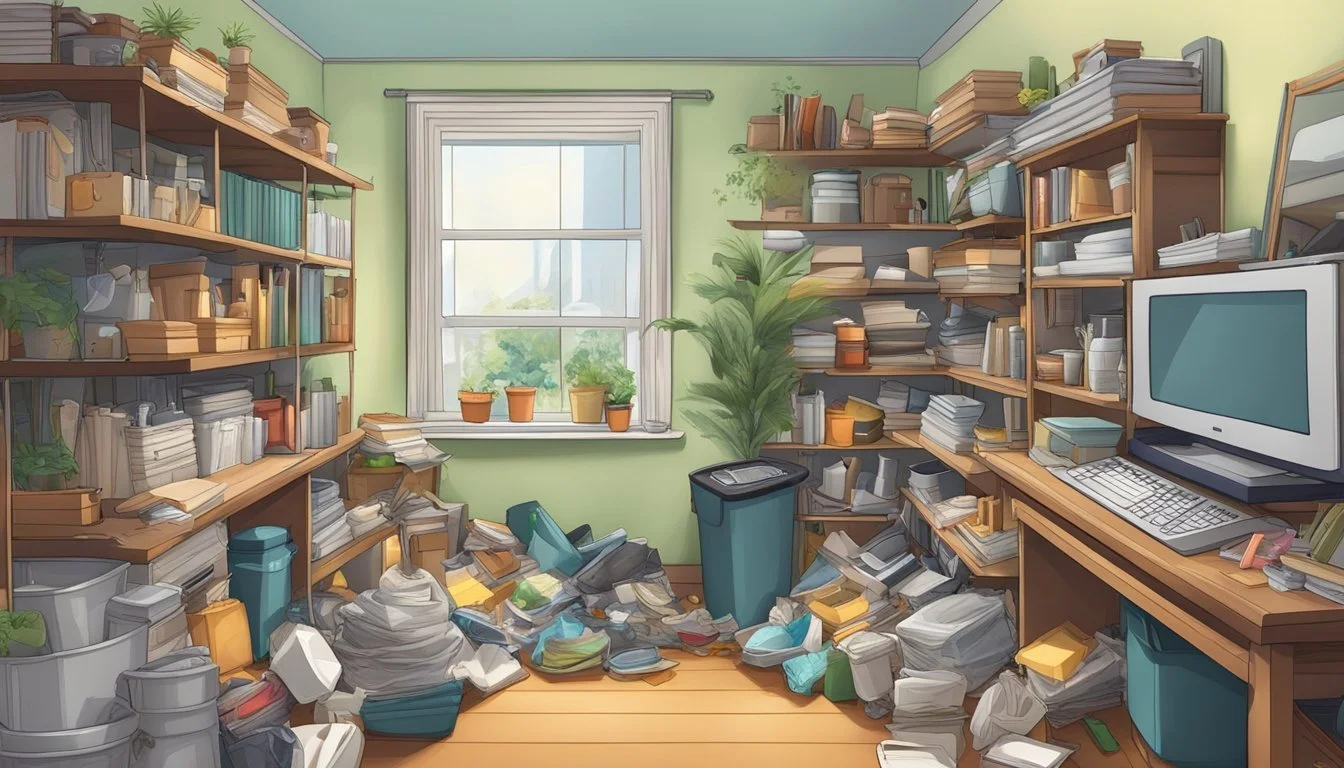Essential Information on Compulsive Accumulation Behaviors
Hoarding disorder is a complex mental health condition characterized by an overwhelming urge to collect and keep possessions, even those with little or no value. People with this disorder experience significant distress at the thought of parting with their items, leading to excessive accumulation that clutters living spaces and impairs daily functioning.
The American Psychiatric Association recognizes hoarding disorder as a distinct mental health condition affecting approximately 1.5% to 6% of the population. Symptoms typically emerge before age 19 but often go unnoticed or untreated for years. The disorder can be triggered or exacerbated by stressful life events such as divorce or the loss of a loved one.
Individuals with hoarding disorder face unique challenges in their day-to-day lives. The inability to discard possessions and the compulsion to acquire new items can lead to unsafe living conditions, strained relationships, and impaired social and occupational functioning. Understanding the complexities of this disorder is crucial for developing effective treatment strategies and support systems for those affected.
Understanding Hoarding Disorder
Hoarding disorder is a complex mental health condition characterized by the persistent difficulty in discarding possessions. It often leads to excessive accumulation of items and significant distress.
Definition and Classification
Hoarding disorder is recognized in the Diagnostic and Statistical Manual of Mental Disorders (DSM-5) as a distinct mental health condition. It involves a strong urge to save items and extreme anxiety when faced with discarding them.
The disorder is classified under obsessive-compulsive and related disorders. It differs from collecting in that hoarded items often lack value or utility.
Hoarding behavior can range from mild to severe, with extreme cases posing safety risks due to clutter.
Symptoms and Behaviors
Key symptoms of hoarding disorder include:
Difficulty discarding possessions regardless of actual value
Intense distress at the thought of getting rid of items
Excessive acquisition of unnecessary objects
Cluttered living spaces that prevent normal use of rooms
Individuals with hoarding disorder may experience:
Strong emotional attachments to possessions
Beliefs that items will be needed in the future
Feelings of safety or comfort from accumulated objects
These symptoms often cause significant impairment in daily functioning and relationships.
Prevalence and Demographics
Hoarding disorder affects an estimated 2-6% of the population. It typically begins in adolescence or early adulthood but often goes unrecognized until later in life.
The disorder affects both men and women, though some studies suggest a slightly higher prevalence in males.
Age distribution:
Age Group Prevalence 55-94 6.2% 34-44 2.3% 18-29 2%
Hoarding tendencies often worsen with age, leading to more severe cases in older adults.
Factors like family history, traumatic life events, and co-occurring mental health conditions may increase the risk of developing hoarding disorder.
Causes and Risk Factors
Hoarding disorder stems from a complex interplay of psychological, genetic, and environmental factors. Research has identified several key elements that contribute to its development and progression.
Psychological Factors
Anxiety and depression often coexist with hoarding disorder. Individuals may use acquired items as a source of comfort or security. Obsessive-compulsive tendencies can manifest in difficulty discarding possessions and excessive acquisition behaviors.
Trauma or stressful life events may trigger hoarding behaviors as a coping mechanism. Some people experience intense emotional attachments to objects, making it challenging to part with them.
Cognitive processes play a role, with hoarders often struggling to categorize items or make decisions about their usefulness.
Genetics and Family History
Studies suggest a genetic component to hoarding disorder. Individuals with a family member who hoards are more likely to develop the condition themselves.
Twin studies have shown higher concordance rates in identical twins compared to fraternal twins, indicating a hereditary link.
Certain genes associated with decision-making and emotional regulation may contribute to hoarding tendencies.
Environmental Influences
Childhood experiences can shape hoarding behaviors. Growing up in a cluttered home or with parents who hoarded increases the risk.
Social isolation may exacerbate hoarding tendencies, as individuals turn to possessions for companionship.
Cultural factors, such as living in a consumer-driven society, can influence acquisition habits.
Traumatic events like the loss of a loved one or financial hardship may trigger or worsen hoarding behaviors.
Living spaces that allow for accumulation without immediate consequences can enable hoarding tendencies to develop unchecked.
Impact on Daily Life
Hoarding disorder significantly affects multiple aspects of a person's daily functioning. The accumulation of excessive items creates challenges that extend far beyond cluttered living spaces.
Health and Safety Concerns
Hoarded items often create unsafe living conditions. Piles of objects can block exits and pathways, posing a serious fire hazard. The buildup of clutter increases the risk of falls and injuries, especially for older adults.
Unsanitary conditions are common in hoarded homes. Dust, mold, and pest infestations thrive in cluttered environments. These factors can lead to respiratory issues and allergies.
Poor hygiene becomes a major concern. Access to bathrooms and kitchens may be limited, making it difficult to maintain cleanliness and prepare healthy meals.
Social and Emotional Effects
Hoarding disorder frequently leads to social isolation. People with this condition often feel ashamed of their living situation and avoid inviting others into their homes.
Relationships with family and friends can become strained. Conflicts may arise over the clutter and its impact on shared living spaces.
Loneliness is a common experience for individuals with hoarding disorder. Their behavior can push away loved ones and make it challenging to form new connections.
Quality of Life
Daily tasks become increasingly difficult as clutter accumulates. Simple activities like cooking, cleaning, or finding important documents can turn into time-consuming challenges.
Stress and anxiety levels often rise due to the constant pressure of managing excessive possessions. The disorder can consume a person's thoughts and energy.
Financial strain may occur from purchasing unnecessary items or paying for storage units. In severe cases, hoarding can lead to eviction or loss of child custody.
Work performance may suffer if hoarding behaviors extend to the workplace. Time management and organization skills are often impacted by the disorder.
Assessment and Diagnosis
Proper assessment and diagnosis of hoarding disorder involves specific criteria and careful evaluation by mental health professionals. The process requires a comprehensive approach to distinguish hoarding from other conditions and understand its impact on an individual's life.
Diagnosis Criteria
Mental health professionals use the Diagnostic and Statistical Manual of Mental Disorders (DSM-5) to diagnose hoarding disorder. The criteria include persistent difficulty discarding possessions, regardless of their actual value. This difficulty stems from a perceived need to save items and distress associated with parting from them.
The resulting clutter must significantly compromise the use of living spaces. The hoarding behavior cannot be better explained by another medical condition or mental disorder. Additionally, the symptoms must cause clinically significant distress or impairment in social, occupational, or other important areas of functioning.
Challenges in Diagnosing
Diagnosing hoarding disorder presents unique challenges. Many individuals with hoarding tendencies may not recognize their behavior as problematic, making self-reporting unreliable. Stigma surrounding hoarding can also lead to reluctance in seeking help or discussing symptoms openly.
Mental health professionals must differentiate hoarding from similar conditions like obsessive-compulsive disorder or depression. Home visits may be necessary to accurately assess the extent of clutter and its impact on daily life. Comorbid conditions, such as anxiety or attention deficit disorders, can complicate the diagnostic process.
Cultural factors and personal history also play a role, requiring sensitivity and contextual understanding from clinicians. Early intervention is crucial, as hoarding tendencies often worsen over time if left unaddressed.
Treatment and Management
Effective treatment for hoarding disorder involves a multi-faceted approach. Professional help, therapy, and support systems play crucial roles in managing symptoms and improving quality of life for those affected.
Therapeutic Approaches
Cognitive-behavioral therapy (CBT) is the primary treatment for hoarding disorder. This skills-based approach helps individuals address beliefs and behaviors linked to clutter accumulation. CBT focuses on:
• Challenging distorted thoughts about possessions • Improving decision-making skills • Practicing discarding items • Developing organizational strategies
Exposure therapy may be incorporated, gradually exposing individuals to the anxiety of discarding items. Therapists often conduct home visits to assess living conditions and provide hands-on assistance.
Group therapy sessions can offer peer support and shared learning experiences. These sessions allow individuals to practice skills in a supportive environment.
Medication
While no medications specifically treat hoarding disorder, some may help manage associated symptoms. Selective serotonin reuptake inhibitors (SSRIs) can be prescribed to address:
• Depression • Anxiety • Obsessive-compulsive tendencies
Medication is typically used in conjunction with therapy for optimal results. Dosages and effectiveness vary among individuals, requiring close monitoring by a healthcare professional.
Support and Resources
Family involvement is crucial in treating hoarding disorder. Education about the condition helps family members:
• Understand the challenges faced by their loved one • Develop strategies to offer support • Avoid enabling behaviors
Support groups provide a non-judgmental space for individuals to share experiences and coping strategies. These groups often include:
• Peer-led discussions • Educational components • Goal-setting activities
Professional organizing services can assist in decluttering and maintaining living spaces. These services work alongside therapeutic interventions to create lasting change.
Online resources offer information, self-help tools, and connections to local support services. Websites of reputable mental health organizations provide valuable guidance for individuals and families affected by hoarding disorder.
Special Considerations
Hoarding disorder presents unique challenges that require specific attention. Certain aspects of hoarding behavior can involve animals or occur alongside other mental health conditions.
Animal Hoarding
Animal hoarding is a severe form of hoarding disorder involving the accumulation of pets. Individuals with this condition often keep far more animals than they can properly care for. They may struggle to provide adequate food, veterinary care, and sanitation.
Animal hoarders typically deny the poor conditions and fail to recognize the negative impact on both the animals and themselves. This behavior can lead to health hazards, legal issues, and significant distress for all involved.
Intervention in animal hoarding cases often requires collaboration between mental health professionals, animal welfare organizations, and local authorities. Treatment focuses on addressing the underlying psychological issues and ensuring proper care for the animals.
Co-occurring Disorders
Hoarding disorder frequently coexists with other mental health conditions. Common co-occurring disorders include:
Depression
Attention Deficit Hyperactivity Disorder (ADHD)
Anxiety disorders
These conditions can complicate diagnosis and treatment of hoarding disorder. For example, individuals with ADHD may struggle with organization and decision-making, exacerbating hoarding tendencies.
Treatment plans for hoarding disorder must account for any co-occurring conditions. Integrated approaches that address multiple disorders simultaneously often yield better outcomes. Cognitive-behavioral therapy and medication management may be tailored to target both hoarding behaviors and symptoms of accompanying mental health issues.
Types of Hoarded Items
Hoarding disorder involves accumulating a wide variety of possessions. The specific items collected can vary greatly from person to person, but certain categories are more common than others.
Commonly Hoarded Items
Newspapers, magazines, and books are frequently hoarded due to perceived informational value. Clothing, often unworn or ill-fitting, piles up as individuals struggle to discard items. Old mail, receipts, and paperwork accumulate as hoarders fear discarding potentially important documents.
Broken appliances and electronics are kept with intentions to repair them. Food containers, plastic bags, and boxes are saved for potential future use. Personal mementos like photos, trinkets, and gifts become overwhelming in quantity.
Some hoarders collect specific items like stamps, coins, or figurines beyond typical collecting behavior. In severe cases, rotting food, trash, and animal waste may be hoarded.
Collecting Versus Hoarding
Collecting involves the deliberate acquisition of specific, often valuable items. Collectors typically organize and display their possessions proudly. The items bring joy and have clear value or purpose.
Hoarding, in contrast, involves accumulating items regardless of actual worth. Hoarders experience distress at the thought of discarding possessions. Their living spaces become cluttered and dysfunctional.
Collectors can typically explain the significance of each item. Hoarders often struggle to justify keeping things but feel unable to part with them. The key difference lies in the level of control and the impact on daily life.
Coping Strategies
Effective coping strategies are essential for managing hoarding disorder. These techniques focus on organizing possessions and reducing the acquisition of new items.
Organizational Techniques
Categorizing items is a crucial first step in organizing possessions. Create designated spaces for different types of objects, using clear storage containers to maintain visibility. Implement a "one in, one out" rule to maintain balance. Set specific goals for decluttering, starting with small, manageable areas.
Use a labeling system to track items and their intended purposes. Regularly review possessions to reassess their value and necessity. Establish daily routines for tidying up and putting items back in their designated places. Consider enlisting the help of a professional organizer or trusted friend for support and accountability.
Reducing Acquisition
Identify triggers that lead to excessive buying or collecting. Create a shopping list and stick to it when making purchases. Implement a waiting period before buying non-essential items to reduce impulsive acquisitions. Unsubscribe from promotional emails and avoid browsing online shopping sites unnecessarily.
Practice mindfulness when considering new purchases. Ask critical questions: "Do I really need this?" "Where will I store it?" "Will I use it regularly?" Explore alternative activities to replace shopping habits, such as hobbies or social engagements. Seek therapy to address underlying emotional needs that may drive acquisition behaviors.
Outlook and Future Directions
Research into hoarding disorder continues to advance, offering hope for improved treatments and outcomes. Cognitive behavioral therapy (CBT) remains a primary focus, with ongoing studies refining techniques to enhance its effectiveness.
New therapeutic approaches are being explored, including virtual reality exposure therapy and mindfulness-based interventions. These innovative methods aim to complement traditional CBT and provide additional tools for managing hoarding behaviors.
Efforts to increase public awareness and reduce stigma surrounding hoarding disorder are gaining momentum. This shift may lead to earlier identification and intervention, potentially improving long-term outcomes for those affected.
Neuroimaging studies are shedding light on the brain mechanisms underlying hoarding behaviors. This research could pave the way for targeted pharmacological treatments in the future.
Quality of life assessments for individuals with hoarding disorder are becoming more comprehensive. These evaluations help tailor treatment plans to address specific challenges faced by each person.
Community-based interventions are showing promise in supporting individuals with hoarding disorder. Collaborative efforts between mental health professionals, social services, and local authorities may lead to more holistic treatment approaches.
As understanding of hoarding disorder grows, so does the potential for improved outcomes. Continued research and treatment innovations offer hope for enhanced quality of life for those living with this challenging condition.









